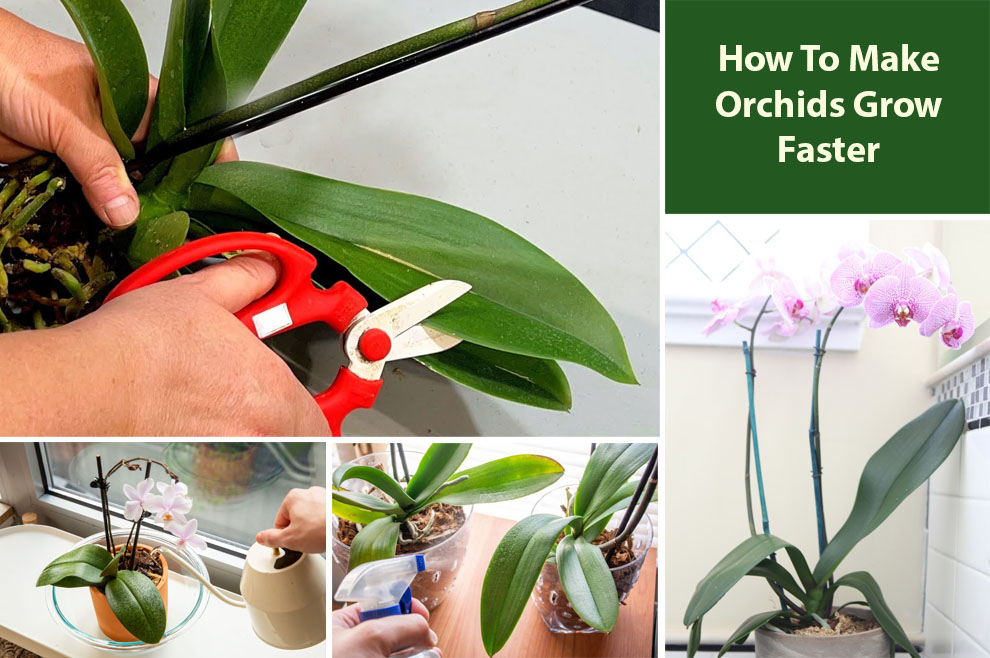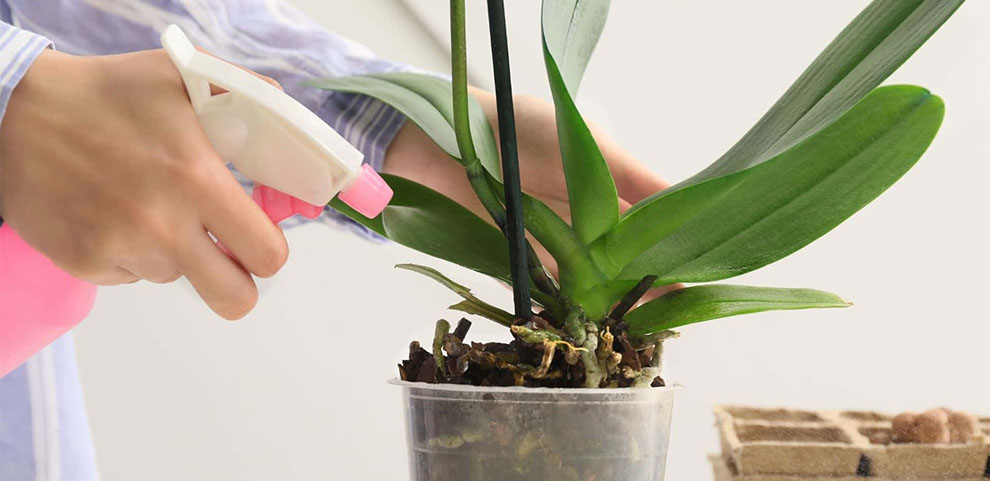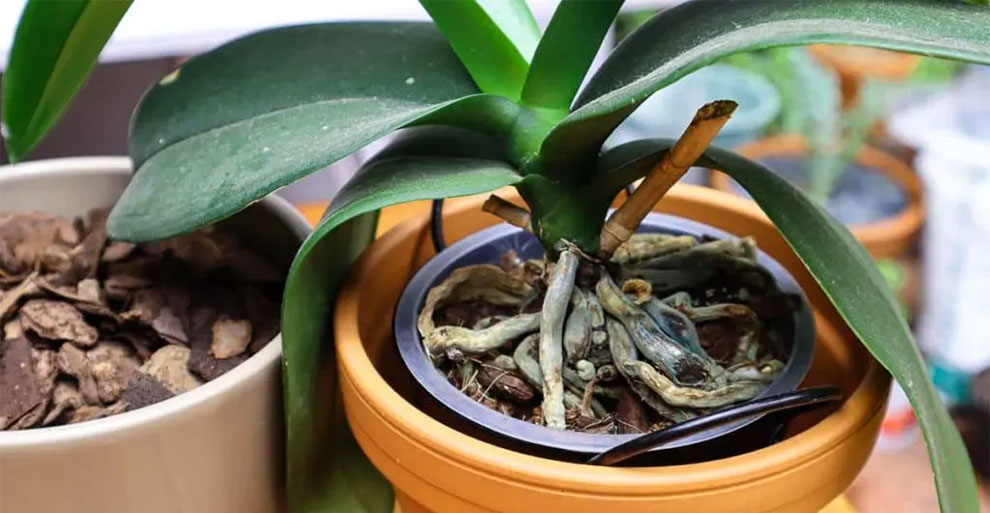Orchid’s New Growth – How To Make It Grow Faster?
There is one thing you can do to make orchids grow faster. And that is to create an environment which is similar to their natural habitat and ideal growing conditions.

Orchids are delicate and exquisite flowers that need care and patience to thrive. Multiple factors influence their growth rate. However, there are some steps you can take to make your orchids bloom and grow faster.
So to understand how to make orchids grow faster, you must be well-versed in your orchids’ specific needs and provide them with optimal conditions that expedite the growth process.
To make your orchids grow faster, you must prioritize their basic growing requirements. Ensure they get ample light, typically indirect or filtered sunlight, to promote photosynthesis.
Further, maintain a consistent temperature range, ideally between 60°F to 80°F (15°C to 27°C), mimicking their natural habitat.
Orchid varieties thrive in humid conditions. So placing them on a tray with water near the plants or using a humidifier can be beneficial. Regularly water your orchids and avoid overwatering or letting the roots dry out.
Beyond all this, orchids also need regular feeding with a balanced orchid fertilizer to provide them with the vital nutrients necessary for their accelerated growth. Mk
Repotting and pruning when necessary also help stimulate their growth. By following these instructions and being watchful of your orchid’s needs, you can build a conducive environment that encourages faster growth and rewards you with flourishing and beautiful orchids.
How Do I Know If My Orchid Is In Active Growth?

Understanding whether your orchid is in an active stage is imperative to learn about its current physiological state and know how to care for it effectively. Here are some signs that indicate your orchid is in its active growth stage:
1. New growth: Inspect the plant for the emergence of fresh leaves, flower spikes, or pseudobulbs (thickened stems). You can see active growth through the development of renewed plant material.
2. Healthy roots: Examine your orchid’s roots. While the orchid is in its active growth stage, you will see greenish or white roots that look firm, plump, and actively growing.
When the roots look mushy or brown, it is a sign of issues like root rot or overwatering.
3. Increased energy: The plant’s energy levels are high while it grows actively. The pseudobulbs should be firm, the leaves must look turgid, and the plant should exhibit vitality.
4. Continuing flowering: Some orchids may yield flowers in their active growth stage. So if your orchid is blooming actively, it is in its active growth phase.
Please note that different orchid varieties have varying growth cycles and patterns. Thus, you must know its specific growing requirements to understand its growth behavior.
By learning these signs, you can know whether an orchid is in active growth and alter its care routine accordingly.
How To Enhance Orchid’s New Growth?
To encourage faster growth in orchids, you must create ideal growing conditions for them starting with soil right away..
Try maintaining a temperature range between 60°F to 80°F (15°C to 27°C) during the day, with a slight drop of a few degrees at night. It mimics their natural environment.
Orchids thrive in high humidity, typically between 50 to 70 percent. Using a humidifier or placing the orchid’s pot on a tray filled with water can help.
Alternatively, regularly misting your orchids can also aid in maintaining the humidity levels.
Next is proper watering, which is imperative. Orchids cherish a dry-out slightly between waterings. Water the plants thoroughly, allowing excess water to drain away. Please do not leave them in standing water.
Provide orchids with indirect or filtered sun and avoid direct light, as it can scorch the leaves. Offering plants a balanced sun is imperative for healthy growth.
Feed your orchids during active growth with a balanced orchid plant food. Follow the packaging instructions to avoid over-feeding, as it can damage the plants.
Repot orchids when orchids’ blooming cycle ceases, and the orchid enters a period of active growth.
How To Make Orchids Grow Faster & Bloom More?
To encourage your orchids to bloom faster, you must employ specialized techniques.
Orchids need a temperature drop of about 10°F to 15°F (5°C to 8°C) at night. It stimulates blooming, and you can achieve it by placing them in a cooler location for a few weeks, such as near a window during the winter months.
Proper feeding also plays a crucial role in blooming. Employ a high-phosphorous orchid plant food or bloom-boosting fertilizer during the period leading to blooming.
Alter the dosage and frequency as instructed by the product label. Provide adequate sun for the orchids, as different orchids have varying sun requirements.
Generally, most species prefer a bright but indirect sun to encourage blooming. So change the distance from the light source accordingly.
Trimming the orchids properly after every bloom helps promote faster blooming. Cut the spent flower spike slightly above the bud or node, ensuring not to damage any potential growth points.
By creating a conducive environment, providing apt feeding, practicing proper pruning techniques, and managing light exposure, you can help your orchids bloom faster and enjoy their exquisite flowers.
How Do You Stimulate Orchid Stem Growth?

Stimulating orchid’s new growth stem development involves providing favorable growing conditions and implementing a proper care routine. Here are some tips to encourage stem growth:
1. Meet the light requirements: Place orchids in bright, indirect light, adjusting distance as needed.
2. Maintain a consistent temperature between 60°F to 80°F (15°C to 27°C) with a slight drop at night.
3. Increase humidity by misting the leaves regularly, placing the pot on a tray with water, or using a humidifier.
4. Be cautious with watering: Ensure slight drying between two watering, but keep the roots consistently moist
5. Always use a balanced orchid fertilizer to stimulate growth.
6. Ensure good air circulation by keeping the windows open or using fans to promote airflow around the orchids.
7. Pruning – Trim damaged or dead stem portions with sterile pruning shears.
By providing optimal growing conditions, consistent care, and maintaining a healthy plant environment, you can stimulate orchid stem growth and enjoy the beauty of a flourishing orchid.
How To Make Orchids Bloom Constantly?
For your orchids to bloom consistently, give them proper orchid care. It includes optimal light conditions, maintaining apt humidity and temperature levels, watering correctly, and feeding regularly.
You must keep an eye on ensuring good air circulation and avoiding disturbances like repotting in the blooming phase.
Offering your orchids favorable conditions and consistent care is necessary for uniform blooming.
What Hampers The Growth Of Orchids?
Multiple factors can negatively impact the orchids’ lifespan and its growth. Understanding the potential hindrance is vital for providing proper care.
Here are some factors that intervene with orchid’s new growth development:
1. Inadequate light: Lack of proper exposure to direct sunlight or insufficient light can hinder orchid growth. It results in weaker stems, lowers photosynthesis, and reduces energy production. All of this stunts orchids’ development.
2. Incorrect temperature: Inconsistent or extreme temperature fluctuations negatively impact orchids’ growth. It may inhibit metabolic processes, cause stress, and curtail plant development.
3. Improper watering impacts your orchids’ growth and health. Overwatering may result in root rot, suffocate the roots, and curtail nutrient absorption.
In contrast, underwatering leads to dehydration and insufficient hydration for healthy growth.
4. Poor drainage: Inadequate drainage in the orchid’s potting medium leads to water-logged roots. It suffocates them and causes root rot. Consequently, roots do not get ample oxygen, impacting nutrient uptake and stunting growth.
5. Incorrect humidity levels: Orchids cherish high humidity levels, and inadequate humidity leads to stressed plants, whereas excessive humidity causes bacterial and fungal diseases that curtail growth.
6. Improper feeding: Orchids need proper feeding for growth, as insufficient feeding results in nutritional deficiencies, impacting growth potential and overall plant growth.
7. Pest and disease infestation: Orchids are susceptible to pests like mealybugs, aphids, and spider mites. Diseases like bacterial and fungal infections may also affect the plant. These infestations weaken the plant and hinder its growth.
8. Poor air circulation: Inadequate air movement around the orchids results in stagnant development and humid conditions. It boosts pathogen growth and curtails the gas exchange that negatively affects the plants’ growth.
9. Repotting at the wrong time: Repotting the orchids during the blooming phase also curtails the growth cycle. Hence, you must transplant them when they finish blooming to avoid stressing the plant.
Related: Orchid Leaves Turning Yellow
How Do I Know If My Orchid Has A New Root Or Flower Spike?

Observe its appearance and location to know if your orchid has a new root or flower spike. New roots show from the plants’ base. They will look light green or white.
Flower spikes show from the center, are thicker, and have nodes indicating flower formation. Their distinct characteristics and location can help distinguish between the two.
How To Tell If Your Orchid Will Bloom Again?
To know if there will be orchid new growth and blooms again, inspect the plant for flower spikes emerging from the plant. Look for green and healthy pseudobulbs or new leaf growth.
Further, they may bloom again if your orchids previously depicted a regular blooming cycle.
What Do You Do With An Orchid After The Blooms Fall Off?
Once the blooms drop from the orchids, you can take some steps:
- Trim the flower spike slightly above the node to trigger re-blooming.
- Provide regular care and establish a conducive environment.
- Monitor for new growth, such as root or leaf development.
- Be patient and maintain consistent care, as orchids take time to re-bloom.
